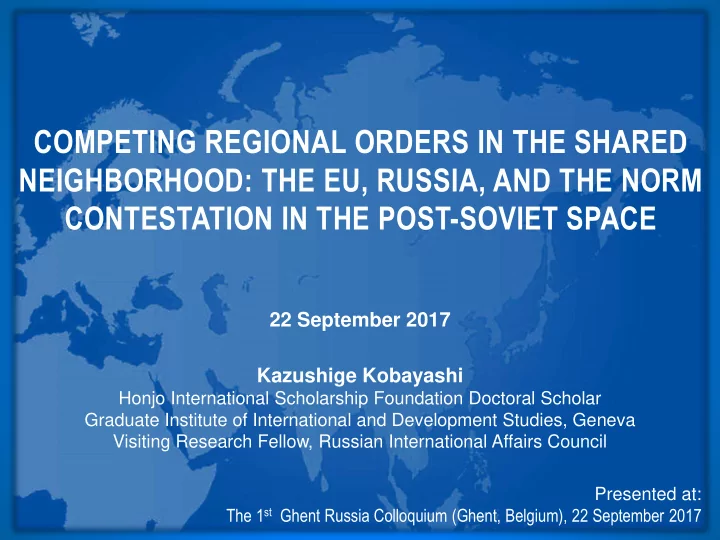

COMPETING REGIONAL ORDERS IN THE SHARED NEIGHBORHOOD: THE EU, RUSSIA, AND THE NORM CONTESTATION IN THE POST-SOVIET SPACE 22 September 2017 Kazushige Kobayashi Honjo International Scholarship Foundation Doctoral Scholar Graduate Institute of International and Development Studies, Geneva Visiting Research Fellow, Russian International Affairs Council Presented at: The 1 st Ghent Russia Colloquium (Ghent, Belgium), 22 September 2017 .
Overview of Presentation 1. Introduction 2. Methodology 3. Analysis 4. Conclusion
Introduction Forms of Governance The Limits of Rational Institutionalist Theory Normative conflict? : As the European integration initiatives have moved ever closer to the domain of the Eurasian integration project advanced by Moscow, the post- Soviet “common neighborhood” has emerged as a field of intense norms competition between the two unions, involving rivaling ideas to order regional politics. Haas’s nightmare? : With deeper and wider involvement of European and Eurasian institutional initiatives, the region has become ever more conflict-prone, with the Ukrainian crisis being just a tip of iceberg. RQ : How do EU and Russian perspectives on regional normative order interact and counteract each other in the post-Soviet space? How does this interaction shape the overall evolution of regional normative order in the shared neighborhood?
Methodology Forms of Governance Norms Matrix Normative Orders : The organic constellation of norms which holistically delineate appropriate range of state behaviors and discourses. Unit of analysis : My unit of analysis is normative order (and not the EU and the EEU per se) deliberately communicated by European and Eurasian institutional initiatives within the post-Soviet space.
Methodology Forms of Governance Norms Matrix
Methodology Forms of Governance Norms Matrix - Example
Methodology Forms of Governance Norms Matrix Small- N , qualitative case study over time : the developments of institutional initiatives in the post-Soviet space during 1999-2016, divided into four case periods (I:1999-2003, II: 2004-08, III: 2009-13, IV: 2014-2016). European Initiatives : Partnership and Cooperation Agreements (PCAs); European Neighborhood Policy (ENP); Eastern Partnership (EaP); Deep and Comprehensive Association Agreements (DCAAs); and to a lesser extent the EU membership (for the Baltics). Eurasian Initiatives : the Eurasian Economic Community (EurRasEC); the Eurasian Customs Union (ECU); and the EEU.
Analysis Forms of Governance Competing for Primacy? European Initiatives: EU’s normative vision for the region was much less ambitious in the earlier period and it embraced a more activist stance only after the colored revolutions, only to downplay the centrality of the “ human-rights-first ” approach in the later years. Eurasian Initiatives: On the Russian side, one can be struck by the adaptation of its normative vision from that of archetypical statism (in the early 2000s) to the gradual (although strategic) embracement of the selected liberal normative elements such as multilateralism, supranationalism, participatory governance.
Conclusion Forms of Governance The Contested Evolution of Regional Orders Mutual Adaptation: The normative visions advanced by Moscow and Brussels have evolved over time, with each side learning from the other as well as taking into account the specificity of regional contexts and the agency of regional states. Contextualization: The democracy-autocracy thesis – that Russia consistently seeks to advocate “authoritarian” norms and the EU seeks to advance “liberal democratic” norms in the shared neighborhood – assumes the timeless singularity of normative order pursued by each side and does not fit the empirical reality. Methodological Innovation : The matrix approach enables norm scholars to capture a more nuanced understanding of norms promoted in the region as well as the complex, interactive, and contested process of evolving regional normative order.
Recommend
More recommend